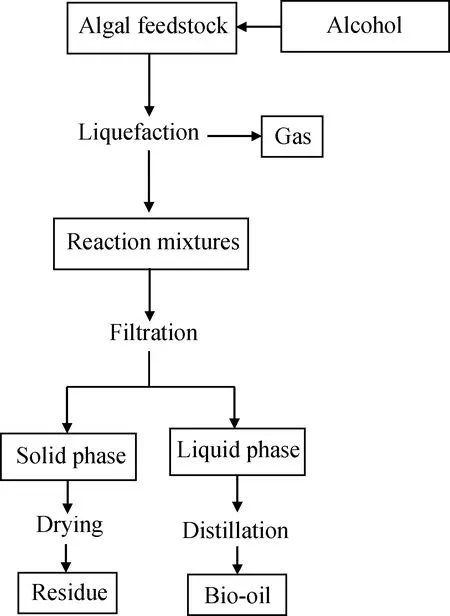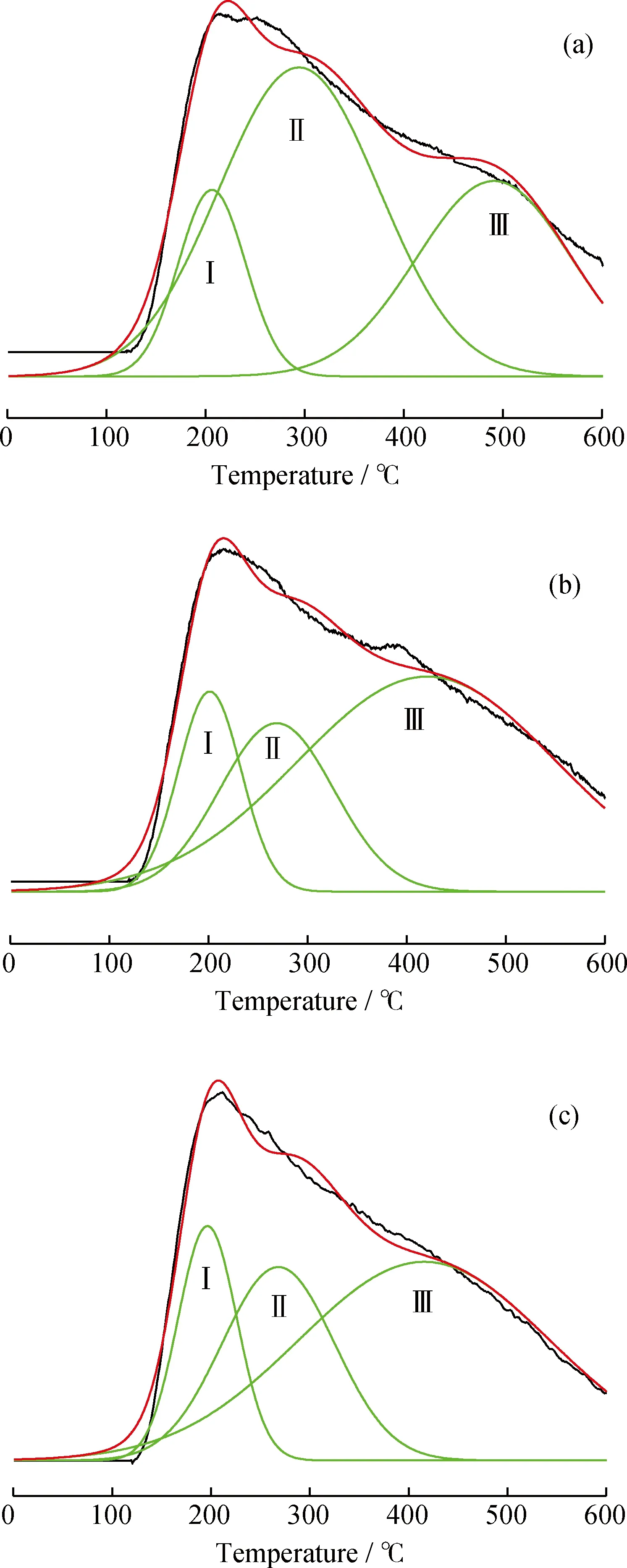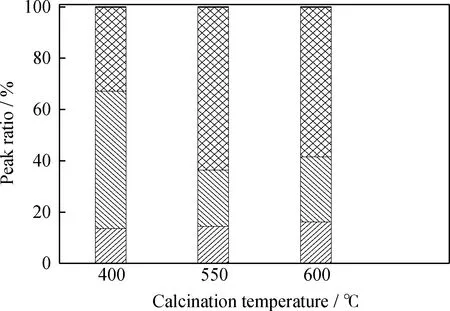固体酸SO2-4/ZrO2在浒苔和小球藻乙醇热液化中的应用
赵永年, 冯丽娟, 刘施施,2, 李 丹, 杨文超,3
(1.中国海洋大学 化学化工学院, 山东 青岛 266100; 2.青岛科技大学 化学与分子工程学院, 山东 青岛 266042;3.国家海洋环境监测中心 海洋化学室, 辽宁 大连 116023)
固体酸SO2-4/ZrO2在浒苔和小球藻乙醇热液化中的应用
赵永年1, 冯丽娟1, 刘施施1,2, 李 丹1, 杨文超1,3
(1.中国海洋大学 化学化工学院, 山东 青岛 266100; 2.青岛科技大学 化学与分子工程学院, 山东 青岛 266042;3.国家海洋环境监测中心 海洋化学室, 辽宁 大连 116023)


随着化石燃料的枯竭及其燃烧对环境污染问题的加剧,可再生的生物能源成为了研究的焦点。藻类热液化技术是一项将藻类转化为生物能源的技术,美国、日本、欧洲、中国等国家和地区已经开展了大量的相关研究[1-2]。藻类的主要成分包括蛋白质、碳水化合物和脂质,这些组分均可以在热液化过程中转化为生物燃料[3],不同类型的藻类组分差异较大,因此在热液化中表现出的性质也有所不同[4]。浒苔是碳水化合物含量较高的大型藻,常见于富营养化的水体中,由于其生长速率快,数目庞大,因此处理浒苔成为了一个棘手的课题。小球藻是蛋白质含量较高的微藻,光合作用效率高,繁殖快,易于人工培养。因此这两种藻类被广泛应用于藻类热液化制生物油的研究中[5-8]。藻类热液化多选乙醇和水作为溶剂,以乙醇为溶剂能降低液化所需温度,改善生物油的品质[9]。

1 实验部分
1.1 试剂
氧氯化锆(ZrOCl2·8H2O)、浓硫酸、浓氨水(质量分数25%)、无水乙醇(质量分数99%)、二氯甲烷,分析纯,国药集团化学试剂有限公司产品;氮气(体积分数99.5%),青岛瑞丰气体有限公司提供。
1.2 藻类原料处理及分析
实验所用浒苔采集于青岛石老人海水浴场,经过除杂、洗涤、干燥和粉碎过程的处理,筛取小于40目的样品冷藏保存备用,小球藻粉购买于陕西帕尼尔生物科技有限公司。分别参照国家标准GB/T 6435-2006、GB/T 6438-2007和GB 212-91测定浒苔和小球藻中的水分(M)、灰分(A)和挥发分(V)含量,固定碳(FC) 含量按式(1)计算。藻类的元素组成C、H、N均采用FLASH2000有机元素分析仪进行测定。
w(FC)=100%—[w(M)+w(A)+w(V)]
(1)
式(1)中,w(M)、w(A)、w(V)和w(FC)分别为水分、灰分、挥发分和固定碳的质量分数,%。
1.3 催化剂的制备与表征

1.4 浒苔和小球藻的乙醇热液化实验
藻类热液化及产物分离流程图如图1所示。本研究所用的液化设备为高压反应釜,加热电压为 0~220 V,搅拌速率为0~800 r/min。取适量藻粉、固体酸催化剂和无水乙醇装入高压反应釜,密封反应釜,用氮气排净釜内空气,设定搅拌速率为300 r/min,打开加热开关开始加热,进行液化反应。当温度升高至设定温度,保持一定时间后关闭加热。待反应釜冷却至室温,打开排气阀排除釜内气体产物后开启反应釜,将反应釜内的固、液产物转移至烧杯中,用无水乙醇清洗反应釜,并将清洗液一起转移至烧杯。抽滤混合产物,滤液在65℃下减压蒸馏除去溶剂得到生物油,将抽滤后的固体残渣置于恒温干燥箱中经110℃烘干至恒重。根据式(2)、(3)分别计算生物油产率和残渣收率。
(2)
(3)
式(2)、(3)中,yb和yr分别表示生物油产率和残渣收率,%;mb、mr和mf分别表示生物油、残渣和原料的质量,g。

图1 藻类乙醇热液化及产物分离流程图Fig.1 Procedure scheme of the ethanol thermal liquefaction and the product separation of algae
1.5 生物油的分析
利用南京多助科技发展有限公司ZR-3R燃烧热实验装置,对液化反应所得生物油进行热值分析,仪器温差分辨率为0.001℃,温度分辨率为0.01℃。采用美国Agilent公司7890A/5975C型气-质联用仪(GC-MS),对生物油的组成进行分析。色谱条件:色谱柱DB-5,30 m×250 μm×0.25 μm。甲醇为溶剂,高纯氦气为载气,流量为1.5 mL/min;分流进样,分流流量20 mL/min;进样口温度280℃,色谱柱初温40℃,保持3 min,10℃/min升温至300℃,保持29 min。根据美国国家标准与技术研究局NIST质谱库确认化合物结构。
2 结果与讨论
2.1 藻类原料的组分和元素分析结果
浒苔和小球藻的组分和元素分析结果见表1。由表1可知,对于浒苔和小球藻,挥发分质量分数都在70%左右,占据了较大的比重。浒苔的灰分质量分数为21.3%,远高于小球藻,这是因为海水藻中无机盐的含量要高于淡水藻。从元素分析结果可知,小球藻中氮含量高于浒苔,说明小球藻含有较多的蛋白质。


表1 浒苔和小球藻的组分和元素分析结果Table 1 Proximate and ultimate analysis results of Enteromorpha prolifera and Chlorella
1) On a dry solid basis


2.3.1 焙烧温度的影响
2.3.2 液化温度的影响



2.4.1 浒苔所得生物油的组成

与浒苔的乙醇热液化相比,浒苔水热液化所得生物油产率较低,一般在20%左右,生物油的组成也不同[8]。浒苔水热液化的产物除了生物油和残渣,还会产生一部分水溶性化合物,如羧酸类、吡啶类、醚类、醇类、酰胺类等物质,这是浒苔水热液化生物油的产率比乙醇热液化生物油产率低的主要原因。浒苔水热液化所得生物油的主要成分是脂肪酸、酮类、烃类、吡嗪类等物质。出现上述的差异主要是因为组成藻类的主要成分的碳水化合物和蛋白质在水热液化和乙醇热液化中的转化路径有很大的差异。

No.Compoundw/%NocatalystWithcatalyst16⁃Deoxy⁃L⁃galactose47 3058 9026⁃Deoxy⁃D⁃galactose13 1118 8831,2,4⁃Triazolidine⁃3,5⁃dione,4⁃methyl⁃L⁃serine4 14—4L⁃2⁃Amino⁃3⁃hydroxypropionicacid—2 605D⁃2⁃Amino⁃3⁃hydroxypropanoicacid—3 336L⁃Pyroglutamicacid2 53—71⁃Methyl⁃2⁃phenylindole2 15—8n⁃Hexanoicacid8 60—9Palmiticacid4 852 60102⁃Hydroxydecanoate4 46—11Heptadecane2 06—12Methylheptanoate4 533 3313Oleicacidethylester3 636 3114Palmiticacidethylester2 644 05

2.4.2 小球藻所得生物油的组成

与浒苔的情况类似,小球藻乙醇热液化的生物油产率要远远高于水热液化,这是因为在水热液化实验中会有水溶性物质的生成,如酚类、羧酸类、酰胺类、吡啶类等物质;此外乙醇会作为反应物参与生成乙酯类化合物,也能提高生物油的产率。不同于乙醇热液化,小球藻水热液化所得生物油的主要成分为脂肪酸、芳烃类物质和吲哚等含氮的杂环化合物[21],这也要归结于碳水化合物和蛋白质在水和乙醇中转化路径的不同。由上述讨论可知,小球藻乙醇热液化生物油产率要高于浒苔,而且生物油组成也不同,小球藻乙醇液化所得的生物油中含有较多的酯类、胺类和吲哚类物质,而浒苔乙醇热液化所得生物油的主要成分是半乳糖、氨基酸类物质,这也是因为两种藻的组成成分差异较大,小球藻含有较多的蛋白质和脂质,而浒苔的主要成分更多是碳水化合物。

No.Compoundw/%NocatalystWithcatalyst11⁃Ethyl⁃2,5⁃pyrrolidinedione1 961 662Dodecylamide8 583 6034⁃Methylindole3 674 624Heptadecane10 046 2759⁃Hexadecenoicacidethylester5 688 016Palmiticacidethylester44 1048 197cis⁃Octadeca⁃9,12⁃dienoicacidethylester11 5412 218(Z)⁃9⁃Octadecenoicacidethylester8 108 7193⁃Phenylpropionicacidethylester4 143 0610Octadecanoicacidethylester2 182 6811Diethylsuccinate—0 99

3 结 论


[1] AA P, F V, P L R. Thermochemical biofuel production in hydrothermal media: A review of sub-and supercritical water technologies[J].Energy & Environmental Science, 2008, 1(1): 32-65.
[2] GUO Y, YEH T, SONG W, et al. A review of bio-oil production from hydrothermal liquefaction of algae[J].Renewable & Sustainable Energy Reviews, 2015, 48: 776-790.
[3] BILLER P, ROSS A B. Potential yields and properties of oil from the hydrothermal liquefaction of microalgae with different biochemical content[J].Bioresource Technology, 2011, 102(1): 215-225.
[4] 陈裕鹏, 黄艳琴, 阴秀丽, 等. 藻类生物质水热液化制备生物油的研究进展[J].石油学报(石油加工), 2014, 30(4): 756-763. (CHEN Yupeng, HUANG Yanqin, YIN Xiuli, et al. Research progress of producing bio-oil from hydrothermal liquefaction of algae[J].Acta Petrolei Sinica(Petroleum Processing Section), 2014, 30(4): 756-763.)
[5] ZHOU D, ZHANG L, ZHANG S, et al. Hydrothermal liquefaction of macroalgaeEnteromorphaproliferato bio-oil[J].Energy Fuels, 2010, 24(7): 4054-4061.
[6] YU G, ZHANG Y, SCHIDEMAN L, et al. Distributions of carbon and nitrogen in the products from hydrothermal liquefaction of low-lipid microalgae[J].Energy & Environmental Science, 2011, 4(11): 4587-4595.
[7] LI H, LIU Z, ZHANG Y, et al. Conversion efficiency and oil quality of low-lipid high-protein and high-lipid low-protein microalgae via hydrothermal liquefaction[J].Bioresource Technology, 2014, 154: 322-329.
[8] YANG W, LI X, LIU S, et al. Direct hydrothermal liquefaction of undried macroalgaeEnteromorphaproliferausing acid catalysts[J].Energy Conversion and Management, 2014, 87: 938-945.
[9] YUAN X, WANG J, ZENG G, et al. Comparative studies of thermochemical liquefaction characteristics of microalgae using different organic solvents[J].Energy, 2011, 36(11): 6406-6412.



[14] PENG L, LIN L, ZHANG J, et al. Solid acid catalyzed glucose conversion to ethyl levulinate[J].Applied Catalysis A: General, 2011, 397(1): 259-265.
[15] QI X, GUO H, LI A L. Efficient conversion of fructose to 5-hydroxymethylfurfural catalyzed by sulfated zirconia in ionic liquids[J].Industrial & Engineering Chemistry Research, 2011, 50(13): 7985-7989.
[16] 陈和, 王金福. 固体酸催化棉籽油酯交换制备生物柴油[J].过程工程学报, 2006, 6(4): 571-575. (CHEN He, WANG Jinfu. Biodiesel preparation from transesterification of cotton seed oil by solid acids catalysis[J].The Chinese Journal of Process Engineering, 2006, 6(4): 571-575.)
[20] 徐友明, 沈本贤, 何金海, 等. 用PASCA及NH3-TPD法表征Al2O3载体表面酸度[J].分析测试学报, 2006, 25(1): 41-44. (XU Youming, SHEN Benxian, HE Jinhai, et al. Study of surface acidity ofγ-Al2O3support by PASCA and NH3-TPD[J].Journal of Instrumental Analysis, 2006, 25(1): 41-44.)
[21] GAI C, ZHANG Y, CHEN W, et al. An investigation of reaction pathways of hydrothermal liquefaction usingChlorellapyrenoidosaandSpirulinaplatensis[J].Energy Conversion and Management, 2015, 96: 330-339.
Application of Solid Acid SO2-4/ZrO2in Ethanol Thermal Liquefaction ofEnteromorphaProliferaandChlorella
ZHAO Yongnian1, FENG Lijuan1, LIU Shishi1,2, LI Dan1, YANG Wenchao1,3
(1.CollegeofChemistryandChemicalEngineering,OceanUniversityofChina,Qingdao266100,China;2.CollegeofChemistryandMolecularEngineering,QingdaoUniversityofScienceandTechnology,Qingdao266042,China;3.DepartmentofMarineChemistry,NationalMarineEnvironmentalMonitoringCenter,Dalian116023,China)
The solid acid catalyst SO2-4/ZrO2was prepared by the impregnation method, and the effect of the solid acid SO2-4/ZrO2on the yield and higher heating value (HHV) of bio-oil from liquefaction of algae was investigated. Results showed that the solid acid catalyst SO2-4/ZrO2calcined at 550℃ had the optimal catalytic activity in bothEnteromorphaproliferaandChlorellaethanol thermal liquefaction, which could increase the yield of bio-oil. Compared with theEnteromorphaproliferaethanol thermal liquefaction without catalyst, the yield of bio-oil increased from 40.54% to 49.82%, while the residue yield decreased from 41.38% to 37.53%. Compared with theChlorellathermal liquefaction without catalyst, the yield of bio-oil increased from 45.10% to 64.84%, while the residue yield decreased from 14.78% to 6.77%. The bio-oil fromEnteromorphaproliferaethanol thermal liquefaction contained a large amount of galactoses, while the bio-oil fromChlorellaethanol thermal liquefaction was composed of ester compounds and nitrogen-containing compounds. In the presence of the solid acid catalyst SO2-4/ZrO2, the content of galactoses increased in the bio-oil fromEnteromorphaproliferaethanol thermal liquefaction and the content of ester compounds increased in the bio-oil fromChlorellaethanol thermal liquefaction.
Enteromorphaprolifera;Chlorella; solid acid; SO2-4/ZrO2; ethanol thermal liquefaction
2016-11-01
“十二五”农村领域国家科技计划课题(2011BAD14B00)资助
赵永年,男,硕士研究生,从事生物质能源开发利用方面的研究;E-mail:15684737757@163.com
冯丽娟,女,教授,博士,从事生物质能源开发利用方面的研究;Tel:0532-66782707;E-mail:fenglj@ouc.edu.cn
1001-8719(2017)03-0447-09
TQ517.4
A
10.3969/j.issn.1001-8719.2017.03.008

